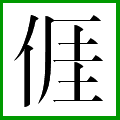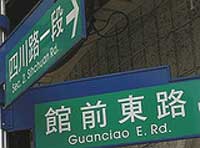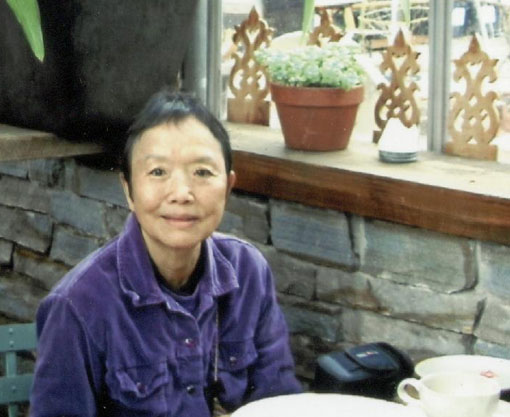President Ma Ying-jeou’s re-election campaign slogan is “Táiwān jiāyóu,” so one can see that all around Taiwan these days, as the election is only about two weeks away.

The Ma campaign has decided that the English translation of “Táiwān jiāyóu” is “Taiwan, Bravo,” which isn’t quite right but at least sounds positive. Of Ma’s two opponents, Tsai Ing-wen (Cài Yīngwén / 蔡英文) of the anti-Hanyu-Pinyin Democratic Progressive Party chose the somewhat cryptic English slogan of “Taiwan next,” while third-party candidate James Soong (Sòng Chǔyú / 宋楚瑜) chose as his slogan “Me, me, me!”
OK, I made that last one up, but only because I couldn’t find the real one, other than maybe it’s “Renew.” (Does anyone know for sure?)
What I really want to talk about here, though, is how Ma’s slogan gets written: 台灣加油.
There is of course nothing unusual about that — except that Ma likes to make a big deal out of using traditional Chinese characters rather than simplified ones. Every year or so Ma talks about how he wants to get the United Nations to declare traditional Chinese characters a super-duper world something-or-other. He has already purged government Web sites of versions that people in China and Singapore could read more easily than versions in traditional Chinese characters. And if he criticizes the PRC, it’s often to tell Beijing that people in China really ought to use traditional characters. Ma’s devotion to people in China being able to have traditional Hanzi reminds me of George W. Bush during the Hainan incident:
“Do the members of the crew have Bibles?” “Why don’t they have Bibles?” Can we get them Bibles?” “Would they like Bibles?”
In other words, while that might be a concern, I sometimes wonder about his priorities.
By now a lot of you are probably thinking, “But 台 is one of those simplified characters that is not only OK to use in Taiwan but also by far more commonly seen than 臺. So what’s strange about this?”
That’s entirely correct. In most cases there would be nothing noteworthy about using “台灣加油” rather than “臺灣加油.” It seems entirely normal. What’s strange here is that the Ma administration actually has a position on the matter of 臺 vs. 台: Although the 台 form can be tolerated in some instances, 臺 is supposedly better and is mandatory in certain cases.
About a year ago, for example, the Ministry of Education reported that official government documents (gōngwén/公文) would have to use the 臺 form. And textbooks would need to be updated to change instances of 台灣, 台北, 台南, 台中, etc., to 臺灣, 臺北, 臺南, 臺中…. Webmasters of some government Web sites scurried to perform a whole lot of search-and-replace. There were not, however, so many instances of 台灣 to change to 臺灣 because Ma had already declared that in Mandarin pages “台灣” (Taiwan) was out and “中華民國” (Zhōnghuá Mínguó / the Republic of China) was in; so mainly this was visible in city names in addresses.
Predictably, though, lots never got changed. (“Close enough for government work.”)
Yes, I know: None of you are deeply shocked by the notion that a politician would tell people to do one thing but do something else himself. And the way the premier downplayed the policy makes me suspect many find it pointless or even embarrassing. Still, the fact remains that the administration did decide not to leave well enough alone and went out of its way to favor 臺 over 台.
Supposedly this is because after the Ministry of Education studied the origins of 臺 and 台, it decided that the tai in the name Taiwan should be written as 臺, according to Chen Hsueh-yu (Chén Xuěyù / 陳雪玉), executive secretary of the ministry’s National Languages Committee.
This doesn’t much sense. Whichever form got used first — which is a dubious method for determining the correctness of usage for something now — the tai in Taiwan doesn’t have anything to do semantically with platforms, terraces, tables, stations, etc. In the case of the origin of the name of Taiwan, there’s no more meaning inherent in 臺 than there is in 台 — or than there is in the Roman letters Tai, either, for that matter. As Victor Mair has noted:
Superficially (according to the surface signification of the two characters with which the name is customarily written), “Taiwan” means “Terrace Bay.” That sounds nice, even poetic, but it is an inauthentic etymology and has nothing whatsoever to do with the actual origins of the name. (This is a typical instance of the common fallacy of wàngwénshēngyì 望文生義, whereby the semantic qualities of Chinese characters interfere with the real meanings of the terms that they are being used to transcribe phonetically.) The true derivation of the name “Taiwan” is actually from the ethnonym of a tribe in the southwest part of the island in the area around Ping’an. As early as 1636, a Dutch missionary referred to this group as Taiouwang. From the name of the tribe, the Portuguese called the area around Ping’an as Tayowan, Taiyowan, Tyovon, Teijoan, Toyouan, and so forth. Indeed, already in his ship’s log of 1622, the Dutchman Comelis Reijersen referred to the area as Teijoan and Taiyowan. Ming and later visitors to the island employed a plethora of sinographic transcriptions to refer to the area (superficially meaning “Terrace Nest Bay” [Taiwowan 臺窝灣], “Big Bay” [Dawan 大灣], “Terrace Officer” [Taiyuan 臺員], “Big Officer” [Dayuan 大員], “Big Circle” [Dayuan 大圓], “Ladder Nest Bay” [Tiwowan 梯窝灣], and so forth). Some of these transcriptions are clever, others are fantastic, but none of them should be taken seriously for their meanings.
I’m not sure how best to characterize — sorry — the differences between “台灣加油” and “臺灣加油.” Although using the 臺 form would definitely come across as more formal, it wouldn’t be exactly the equivalent of “Fight Fiercely, Harvard.” Yet the use of the 台 form isn’t really the equivalent of a campaigning politician droppin’ his g’s either.
臺 vs. 台
Additional sources:

Please don’t write to comment for or against simplified characters in general. This post isn’t about that really, even though 臺 could serve as a poster child for Hanzi simplification.




 Since I just posted about the new
Since I just posted about the new  Taiwan’s Ministry of Education has released software for Windows and Linux systems that uses Hakka romanization for the inputting of Chinese characters.
Taiwan’s Ministry of Education has released software for Windows and Linux systems that uses Hakka romanization for the inputting of Chinese characters.  With Taiwan’s presidential election less than six months away and various position papers being issued, perhaps it’s time to take a look at where the opposition stands on romanization.
With Taiwan’s presidential election less than six months away and various position papers being issued, perhaps it’s time to take a look at where the opposition stands on romanization. 

